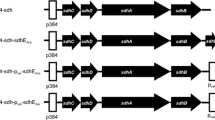Abstract
The oxidation of succinate with elemental sulphur in Desulfuromonas acetoxidans was investigated using a membrane preparation of this bacterium. The following results were obtained:
-
1.
The preparation catalyzed the oxidation of succinate with sulphur and NAD. These reactions were dependent on ATP and were abolished by the presence of protonophores or dicyclohexylcarbodiimide (DCCD).
-
2.
The membrane preparation also catalyzed the reduction of fumarate with H2S or with NADH. These activities were not dependent on ATP and were not affected by protonophores or DCCD.
-
3.
By extraction-reincorporation experiments it could be shown that menaquinone is involved in electron transport between H2S and fumarate and between NADH and fumarate.
-
4.
The membrane fraction catalyzed the reduction of the water-soluble menaquinone-analogue dimethylnaphthoquinone (DMN) by succinate, H2S, or NADH, and the oxidation of DMNH2 by fumarate. These activities were not dependent on the presence of menaquinone and were not influenced by ATP.
-
5.
The activities involving succinate oxidation or fumarate reduction were similarly sensitive to 2(n-nonyl)-4-hydroxyquinoline-N-oxide, while H2S and NADH oxidation by DMN were not affected by the inhibitor.
It is concluded that the catabolism of D. acetoxidans involves the energy-driven oxidation of succinate with elemental sulphur or NAD as electron acceptors and that menaquinone is a component of the electron transport chain catalyzing these reactions.
Similar content being viewed by others
Abbreviations
- DMN:
-
2,3-Dimethyl-1,4-naphthoquinone
- TTFB:
-
4,5,6,7-Tetrachloro-2′-trifluoromethylbenzimidazole
- NQNO:
-
2(n-Nonyl)-4-hydroxyquinoline-N-oxide
- DCCD:
-
N,N′-Dicyclohexylcarbodiimide
- APAD:
-
3-Acetylpyridineadenine-dinuclcotide
References
Anderson BM, Kaplan NO (1959) Enzymatic studies with analogues of diphosphopyridine nucleotide. J Biol Chem 234:1226–1232
Bache R, Kroneck PMH, Merkle H, Beinert H (1983) A survey of EPR-detectable components in sulfur-reducing bacteria. Biochim Biophys Acta 722:417–426
Bode CH, Goebell H, Stähler E (1968) Zur Eliminierung von Trübungsfehlern bei der Eiweißbestimmung mit der Biuretmethode. Z Klin Chem Klin Biochem 5:419–422
Büchel KH, Korte F (1965) Hemmung photosynthetischer Reaktionen durch NH-acide Imidazole and Benzimidazole. Angew Chem 20:911–912
Erecinska M, Wilson DF (1981) Inhibitors of mitochondrial functions. Pergamon Press, Oxford New York Toronto Sydney Paris Frankfurt
Futai M, Kanazawa H (1983) Structure and function of protontranslocating adenosine triphosphatase (F0F1): Biochemical and molecular biological approaches. Microbiol Rev 47:285–312
Gebhardt NA, Thauer RK, Linder D, Kaulfers P-M, Pfennig N (1985) Mechanism of acetate oxidation to CO2 with elemental sulfur in Desulfuromonas acetoxidans. Arch Microbiol 141: 392–398
King TE, Morris RO (1967) Determination of acid-labile sulfide and sulfhydryl groups. In: Estabrook RW, Pullman ME (eds) Methods in enzymology, vol X. Academic Press, New York San Francisco London, pp 634–641
Klingenberg M, Schollmeyer P (1960) Zur Reversibilität der oxydativen Phosphorylierung. Adenosintriphosphat-abhängige Atmungskontrolle und Reduktion von Diphosphopyridin-nucleotid in Mitochondrien. Biochem Z 333:335–350
Kröger A (1974) Electron-transport phosphorylation coupled to fumarate reduction in anaerobically grown Proteus rettgeri. Biochim Biophys Acta 347:273–289
Kröger A, Innerhofer A (1976) The function of menaquinone, covalently bound FAD and iron-sulfur protein in the electron transport from formate to fumarate of Vibrio succinogenes. Eur J Biochem 69:487–495
Kröger A, Winkler E, Innerhofer A, Hackenberg H, Schägger H (1979) The formate dehydrogenase involved in electron transport from formate to fumarate in Vibrio succinogenes. Eur J Biochem 94:465–475
Kruber O (1929) Über das 2,3-Dimethyl-naphthalin im Steinkohlenteer. Ber Deutsche Chem Ges, pp 3044–3046
Pfennig N, Biebl H (1976) Desulfuromonas acetoxidans gen. nov. and sp. nov., a new anaerobic, sulfur-reducing, acetate-oxidizing bacterium. Arch Microbiol 110:3–12
Pfennig N, Widdel F (1981) Ecology and physiology of some anaerobic bacteria from the microbial sulfur cycle. In: Bothe H, Trebst A (eds) Biology of inorganic nitrogen and sulfur. Springer, Berlin Heidelberg New York, pp 169–177
Solioz M (1984) Dicyclohexylcarbodiimide as a probe for proton translocating enzymes. TIBS 9:309–312
Thauer RK, Morris JG (1984) Metabolism of chemotrophic anaerobes: old views and new aspects. In: Kelly DP, Carr NG (eds) The microbe 1984. Part II. Procaryotes and eukaryotes. Soc Gen Microbiol Symposium 36, Cambridge University Press, pp 123–168
Thauer RK, Jungermann K, Decker K (1977) Energy conservation in chemotrophic anaerobic bacteria. Bacteriol Rev 41:100–180
Vogel G, Steinhart R (1976) ATPase of Escherichia coli: purification, dissociation, and reconstitution of the active complex from the isolated subunits. Biochemistry 15:208–216
Author information
Authors and Affiliations
Rights and permissions
About this article
Cite this article
Paulsen, J., Kröger, A. & Thauer, R.K. ATP-driven succinate oxidation in the catabolism of Desulfuromonas acetoxidans . Arch. Microbiol. 144, 78–83 (1986). https://doi.org/10.1007/BF00454960
Received:
Accepted:
Issue Date:
DOI: https://doi.org/10.1007/BF00454960




